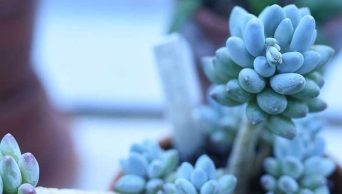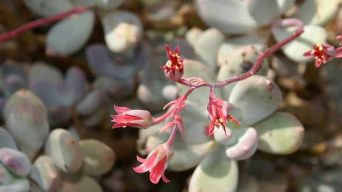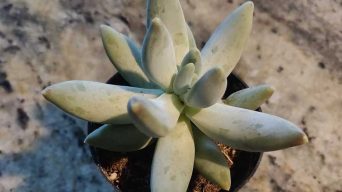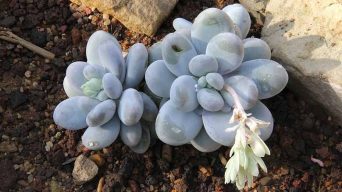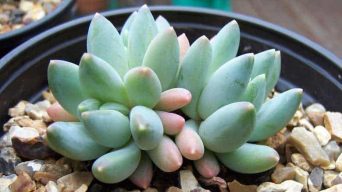The Pachyphytum viride succulent plant is perfect for any garden, indoors or out!
It’s easy-to-care-for, drought-tolerant, and has an attractive shape that makes it stand out among other plants!
You won’t regret adding this succulent plant to your home today!
Learn how to care for, propagate, and grow one of the easiest succulents around.
This complete guide will be your go-to resource for everything you need to know about growing a Pachyphytum viride succulent plant.
Overview
Pachyphytum viride is a succulent plant in the Crassulaceae family, native to Mexico.
The Pachyphytum viride succulent is a large species with ascending or hanging branches and leaves organized in loose rosettes.
The stems can be up to 3.3 feet (1 m) and up to 1.4 inches (3.5 cm) wide.
The green to violet leaves can grow up to 4 inches (10cm) long, and flowers come in various colors ranging from red to orange.
It blooms from winter to early springtime atop stems that can be 12 inches (30 cm) or taller!
How To Care for Pachyphytum Viride
Pachyphytum viride care is relatively easy to follow.
Below you’ll find the most important information you need to know about caring for Pachyphytum viride.
Sun Exposure & Light Requirements
Pachyphytum viride are succulent plants that can be grown in partial shade to full sun but require a minimum of 5-6 hours of direct sunlight each day.
When grown outdoors, the Pachyphytum viride plants prefer full sun or partial sun.
Pachyphytum plants need full sun because it helps them achieve their reddish-orange coloration rather than the gray coloring they receive when grown in low-light conditions.
They also dislikes direct midday summer sun, requiring succulents planted outdoors to be positioned where midday rays do not directly hit them for a few hours during the hottest part of the day.
Pachyphytum plants that are not receiving enough sunlight will begin to stretch and lose their compact shape.
Pachyphytum viride plants work well in a window indoors. Ensure that you provide Pachyphytum viride with at least 5 to 6 hours of bright light daily.
Watering Requirements
Pachyphytum viride should be watered when the soil is dry, and avoid getting water on the leaves as it may cause spotting or leaf rot.
It shouldn’t be overwatered at any time of the year to prevent root rot problems.
Pachyphytum should be watered when the soil is dry to a depth of at least 2 inches (5cm) Pachyphytum should be watered infrequently and allowed to dry out between waterings.
Potted Pachyphytum requires more frequent watering than Pachyphytums planted in the ground because pots have a smaller volume of soil for water absorption (or wicking) than garden soil, but both need good drainage.
Soil Requirements
The soil requirements of the Pachyphytum viride succulent are similar to other succulents: well-draining, loose soils such as cactus or succulent potting soil to prevent root rot.
It is a succulent plant, so in your soil mixture, make sure to include sand and peat moss instead of vermiculite or composted pine bark which retains too much moisture for Pachyphytum plants.
To improve drainage, the soil should also be gritty (instead of soft and muddy).
Pachyphytum viride is a slow-growing plant, so you can add perlite or coarse sand to the soil mixture for aeration without worrying about Pachypodium roots outcompeting other plants (like faster-growing cacti).
Temperature and Humidity
The Pachyphytum viride succulents should be kept at a temperature of 68° – 80° Fahrenheit. They should have 50° – 70° F. nights and 40% relative humidity.
Pachyphytum plants can survive in cooler temperatures but not grow or flower as much.
They may also lose all of their leaves if they get too cold or even die, so if you want them to thrive, you will need to give your Pachyphytum the proper temperature.
Pachyphytum plants can get by without much humidity, but Pachyphytum viride care recommends keeping the relative humidity at 40%.
Pachophytum will not do well in a humid environment and may begin to lose their leaves.
They grow most quickly in hot and sunny environments with lots of air circulation.
It would be best to put them outside when possible because Pachyphytum needs sunlight to flower.
Fertilizing
Pachyphytum viride needs to be fertilized only once a month during the growing season.
They need a diluted fertilizer that is half-strength. Pachyphytum viride requires a 10-30-10 or 20-20-20 fertilizer.
To fertilize Pachyphytum viride, water the plant first with tepid water to allow the Pachyphytum viride leaves to open up. Then apply diluted fertilizer on top of your Pachyphytum viride soil mix.
Pachyphytum will not always need fertilizing; sometimes, the plants have enough nutrients in them already.
Be careful not to overdo it with Pachyphytum viride fertilizing.
Pachyphytum plants are flowering succulents, so over-fertilizing Pachyphytum will cause the plant to produce many side shoots and eventually grow very leggy and thin.
If you do not have Pachyphytum flowers on your Pachys, consider this an indication of under-fertilization.
Potting and Repotting
Pachyphytum viride pots usually are ceramic or plastic; using clay pots is not recommended.
A Pachyphytum viride succulent needs to be repotted occasionally when the plant reaches 5 inches in-depth and can grow up to 8 inches wide.
The best pots for this type of succulent are ones that are no more than 5 inches deep with large drainage holes at the bottom.
Pachyphytum Plants prefer to have dry feet – don’t let them sit in water.
When repotting, do it in the spring or summer after your Pachyphytum has flowered and is beginning to show signs of new growth.
Pachyphytum viride plants must be repotted every two years to make sure the Pachyphytum does not get root-bound.
When repotting your Pachyphytum, you will want to remove up to half of the soil in the old pot.
This will allow you to add more soil if needed and remove any dead roots that may be present in your Pachyphytum plant.
Pruning
Pachyphytum viride pruning can be performed by simply removing dead or dying leaves, but constant maintenance is required to keep your plant looking its best.
Pruning the roots and stems of your Pachyphytum viride will increase their overall health and appearance.
The most important step in maintaining your Pachyphytum viride look is to prune them regularly. This will remove any brown or damaged portions of the plant, which will make your succulent plant happier and more packed.
The best time for Pachyphytum viride pruning is early in the spring.
Pachyphytum viride plants have been resting for the entire winter, and pruning will encourage new growth and ensure that your succulent plant looks its best throughout all seasons.
Pests and Diseases
The Pachyphytum viride is vulnerable to several pests and diseases.
Common Pests
Aphids and mealybugs are the most common pests affecting the Pachyphytum viride succulent.
Aphids
Pachyphytum viride succulents are prone to infestation by aphids.
Aphids feed on Pachyphytum roots and stems, causing them to curl and become unhealthy.
These Pachyphytum pests also excrete a sticky substance called “honeydew,” causing the leaves to get covered in it, grow black sooty mold, attract ants, and have an overall negative impact on Pachyphytum health.
Aphids can be treated with an insecticidal soap spray.
Another option is to release ladybugs into your Pachyphytum garden. Ladybugs will consume Pachyphytum pests while not harming the plants or other beneficial insects.
Mealybugs
Also, Pachyphytum pests are mealybugs that suck the roots causing the stems to break and become distorted and unhealthy.
Pachyphytum stems infected by mealybugs may also appear stunted or misshapen when paired up against healthy plants of similar age and size.
Pachyphytum plants are vulnerable to mealybugs due to the succulents’ surface texture which is ideal for pests to attach themselves to.
The use of an insecticidal soap spray can eliminate mealybugs.
Another option is to crush them between your fingers and then dispose of the pests in soapy water.
Common Diseases
The most common diseases that affect the Pachyphytum viride succulent are root rot and leaf spots.
Root Rot
Root rot is the Pachyphytum plant’s most prevalent disease. The Pachyphytum soil becomes too wet, and root rot sets in.
Pachyphytum plants with root rot cannot absorb enough water from the soil due to their roots being affected by pathogens, which causes the leaves to wilt and their entire growth to become stunted.
Excess moisture must be removed from the soil to remedy Pachyphytum viride root rot.
The plants can be transplanted to lift the roots out of the ground and make the soil more breathable.
Root rot will also eventually subside if the plant is moved or replanted while maintaining proper soil moisture levels.
Leaf Spots
Another common disease is leaf spots which affect Pachyphytum viride leaves.
The most common types of leaf spots are caused by fungi that thrive on wet Pachyphytum plants.
Leaf spots can appear as small brown, grey, black, or yellow blotches on the leaves.
These leaf spots look like stains, and the leaves will eventually turn black and die if the leaf spot disease is not treated.
A fungicide spray may be used to eliminate leaf spots.
The Pachyphytum viride succulent caretaker should also ensure that the plants have plenty of air circulation so that they don’t remain damp for prolonged periods, promoting the spread of diseases.
How to Care for Pachyphytum Viride in Winter
Pachyphytum viride succulent winter care is generally straightforward. They are usually winter hardy as a group and overwinter without many problems, except during very harsh winters.
Pachyphytum can withstand temperatures down to the freezing point. They are not frost resistant but do not sustain any lasting damage from occasional light frosts.
Pachyphytum viride will turn black temporarily when temperatures drop below freezing and die back to the ground.
The Pachyphytum viride prefers warmth during winter as well and can be grown outdoors in frost-free climates. Pachyphytum plants have been known to overwinter outside if temperatures only drop occasionally below freezing point.
Pachyphytum does need lots of light during wintertime, but be aware that it should have partial shade to prevent leaf burn. They prefer the morning sun; Pachyphytum plants don’t react well if exposed to the direct sun for too long in winter.
These plants require less water in winter as their root systems are more compact, with a reduced need for water.
Pachyphytum also enjoys being left dry between watering periods. They grow best in dry and well-drained soil.
Pachyphytum viride plants should never be allowed to stand in water, as this will kill the plant quickly.
How To Propagate Pachyphytum Viride
Pachyphytum viride can be propagated by a process called leaf propagation or leaf cuttings propagation.
Pachyphytum viride propagation does not involve any complicated steps, and you will see why it is such an effortless task.
First, choose a Pachyphytum viride leaf with a good set of ribs and without any cracks.
Propagation will not be successful if you use a Pachyphytum leaf that is damaged or cracked in any way.
Let the Pachyphytum viride leaf callus for about three days before planting it into your substrate.
During this waiting period, keep your Pachyphytum viride propagating leaves in a shaded area, avoiding hot sunlight because it may cause damage to the leaf.
If you do notice some callous appearing at the cut end of the leaf after three days, it is time to plant it in your potting medium.
Pachyphytum propagating leaves do not need to be planted too deep into the substrate.
You must plant Pachyphytum leaves with the cut ends facing downward and the Pachyphytum leaf ribs facing upwards.
Pachyphytum propagation works best if you use a small pot or container for your new Pachyphytum plants. That way, it will grow faster in healthy conditions.
The new plant will start to form its first roots in the second or third week.
Once Pachyphytum has developed new leaf growth and has a yellowish-green color, you may now transplant your Pachyphytum succulents into larger containers as they grow.
Pachyphytum viride propagation is simple and easy to do, but it requires patience; do not discard any damaged leaves, yet keep them for future use.
Is the Pachyphytum Viride Toxic?
Pachyphytum viride plants are generally not toxic to people or animals.
However, Pachyphytum viride plants are generally considered safe for people but can release a sap if damaged which may cause contact dermatitis or hives in sensitive individuals.
Always use protective gloves when handling this plant to prevent any allergy reactions.
Final Thoughts
If you’re looking for a succulent plant, this one might be perfect for your home. It’s easy-to-care-for, hardy, and will bring tons of life into any room it inhabits.
Pachyphytum viride is a plant that’s perfect for any desert-style garden or if you’re looking to add some life and color to your home.
You won’t regret adding this beautiful plant to your home today!


